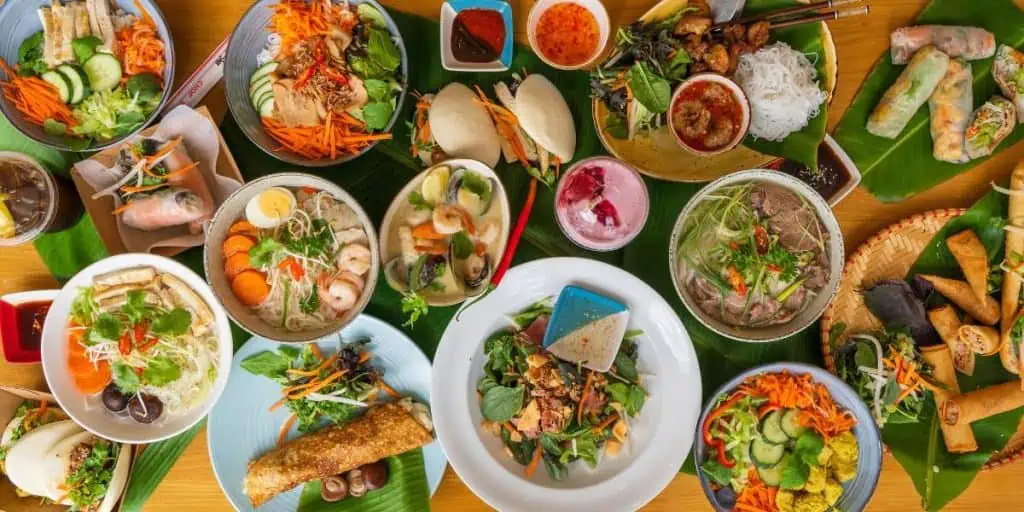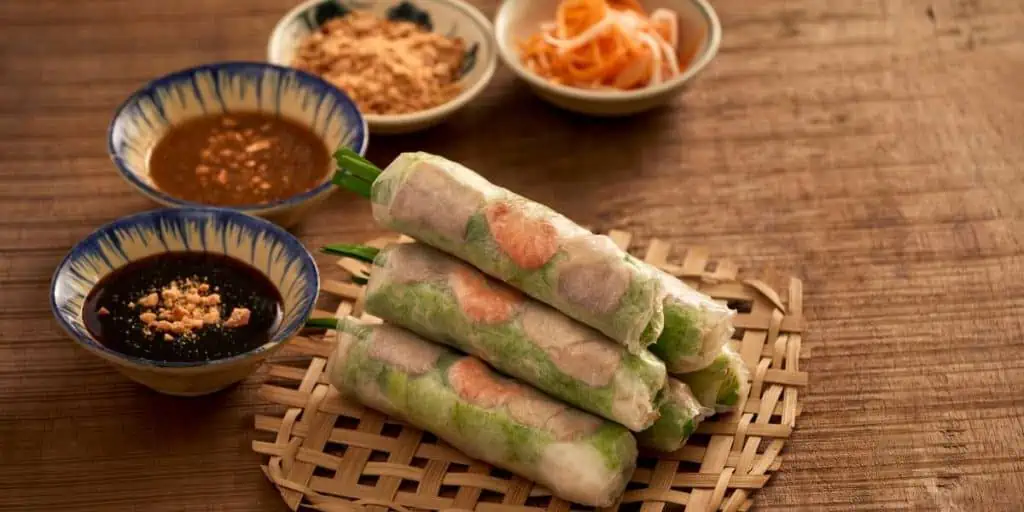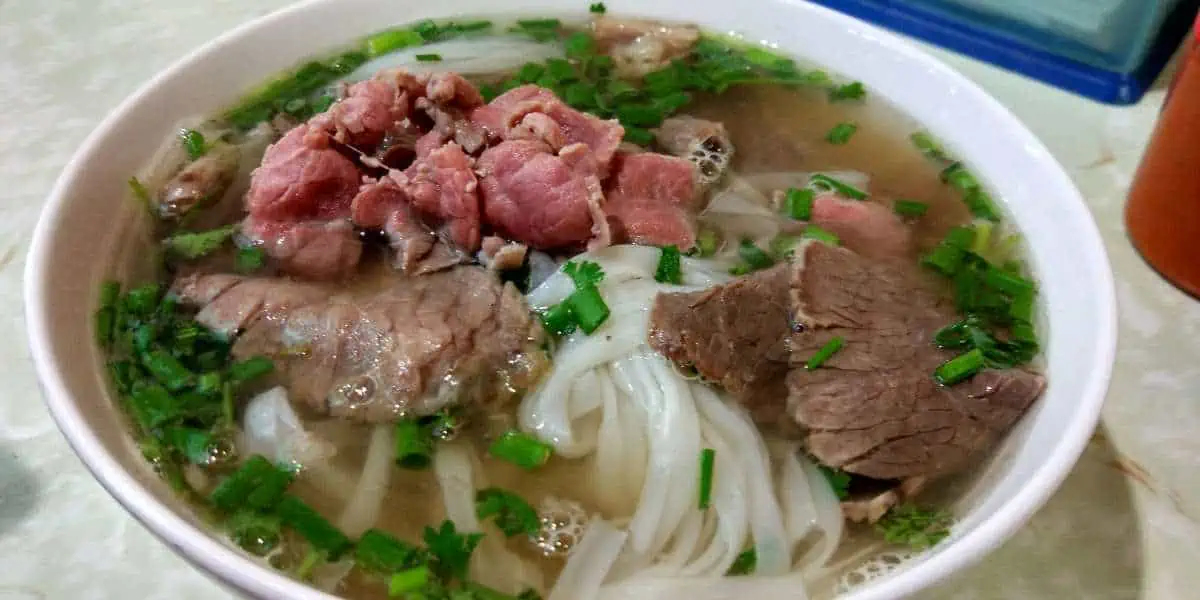Discover the vibrant flavors, captivating sights and aromatic scents that define the culinary soul of Vietnam. From bustling street food escapades to hands-on cooking classes with passionate local chefs, Vietnam offers an abundance of mouthwatering experiences for the adventurous food lover.
Introduction
Vietnam boasts one of the most revered culinary traditions in Southeast Asia. Its cuisine reflects a rich dynasty of influences from Chinese to French occupations, resulting in a diverse blend of sweet, salty, sour and spicy flavors.
The landscape provides a bounty of fresh ingredients like herbs, vegetables, noodles and meat that seasoned Vietnamese cooks have perfected into iconic staples over centuries. Signature dishes like the hearty phở noodle soup, crunchy bánh mì sandwiches and delicate spring rolls give just a glimpse into Vietnam’s complex cuisine.
Beyond the classics, adventures through back-alley markets and family-run street food stalls unveil rare delicacies and time-honored cooking methods unique to each region. Hands-on cooking classes also invite visitors into the cultural traditions surrounding Vietnamese fare.
Uncover Authentic Vietnamese Cooking Techniques
Cooking classes provide an interactive gateway to unraveling the fundamental ingredients, preparation methods and cultural customs intrinsic to Vietnamese cuisine. Most tours begin in the fresh food markets, where the simplicity of ingredients and emphasis on freshness immediately sets Vietnamese cooking apart.
Herbs like cilantro, basil and mint take center stage, along with vegetables like bean sprouts and noodles made from tapioca or rice. Instead of complex spice blends, Vietnamese cooking relies on nuanced flavor balancing using signature condiments like fish sauce, soy sauce and lime.
Hands-on instruction in chopping techniques, marination and achieving perfect wok temps helps to demystify some of the secrets that elevate Vietnamese food to its refined elegance. Beyond the cooking lessons, students receive insight into traditional dining etiquette, meal structure and how to source authentic ingredients.
Signature Dishes Showcase Balance and Finesse
From the charred smokiness of grilled meats to the comforting brothiness of noodle soups, cooking classes explore the pillar dishes of Vietnamese fare. The delicate rice paper wraps enclosing fried spring rolls receive crisp exterior contrasting the tender shrimp and vegetables inside. Grilled skewered lemongrass beef (thịt nướng) and the iconic bánh mì sandwich balance sweet, sour, salty and spicy flavors in perfect harmony.
Of course, no Vietnamese cooking class is complete without unraveling the layered flavors of the national dish phở. This delicate soup features bone broth laden with tender rice noodles, aromatic herbs and thin slices of beef, infused over hours to form a perfect symphony of tastes and textures. Hands-on phở making classes teach how to extract maximum flavor from each ingredient.
Discover Regional Ingredients and Traditions
Just like the diverse landscapes spanning Vietnam, the cuisine shifts dramatically between the North, Central and Southern regions. From the center of royal power in Hanoi to the spice markets of Saigon and coastal fishing villages in between, Vietnamese cooking classes explore centuries of distinct cultural influences.
North Vietnam (Tonkin)
As the seat of power and learning for centuries, the elegant cooking of Northern Vietnam shows Imperial Chinese and French sensibilities. Focus lies more on balance and natural flavors using subtle herbs and oils rather than intense spices.
Signature Northern dishes like bún chả (grilled pork with noodles) and phở noodle soup rely on pork, rice and nuanced broths. Fish from the Red River Delta also factors heavily into everyday meals. Through Northern cooking classes, understand the traditions of ingredient combinations and preparation techniques intrinsic to Hanoian cuisine.
Central Vietnam (Annam)
With its legacy as the seat of the Champa Kingdom and major port centers, Central Vietnamese food shows the convergence of mountain tribes and coastal fishing villages. As the spice trade passed through bustling port cities like Hoi An, it left behind foreign flavors that mingle with indigenous fare.
Food tours sample the celebrated street foods here like spicy beef noodle soup called bún bò Huế, or the crackers bánh tráng nuong, seared over open grills. Cooking classes run by locals dive into preparing regional specialties, highlighting ingredients like turmeric, lemongrass and shrimp paste. Visitors also learn about central Vietnamese food rituals and holiday traditions surrounding celebratory meals.
Southern Vietnam (Cochinchine)
The lush, tropical south remains heavily influenced by its role in the spice trade and French colonial ties. Southern Vietnamese cuisine turns up the heat using heady flavors like coconut milk, tamarind, garlic, shallots and fingerroot. Fish sauce also makes a ubiquitous appearance to provide the quintessential salty richness.
Through cooking classes and food tours in hectic Ho Chi Minh City and the tranquil Mekong Delta, visitors access rare rural specialties and local innovations. Southern Vietnam offers a wide diversity of flavor-packed fare to discover, from sweet sticky rice dishes to aromatic curries.
Street Food Adventures: A Culinary Symphony of Vietnam’s Streets
While cooking classes provide fundamental immersion into Vietnamese cuisine, venturing to the streets offers the most visceral experience through flavors, sights and sounds. An explosion of mouthwatering aromas emanates from makeshift kitchens and pushcarts across cities and villages.
Patronizing beloved street food vendors and markets provides economic sustenance while preserving culinary traditions. Vietnamese street eats like crunchy fried eel, pungent fish sauce wings or pan-fried Sticky Rice Cakes (Bánh Căn) also help fuel social interaction.
Tantalizing Tastes From Dawn to Dusk
From first light when vendors begin hawking steaming cups of dense iced Lavazza coffee, followed by sweet Bánh Cuốn rice noodle rolls, Vietnamese streets churn out snacks all day. Visitors can graze on Xôi Sticky Rice or crispy Bánh Tráng open rice crackers.
As the lunch rush hits, slurp down noodle classics like Phở or Bún Chả kept warm in mobile kitchens. Or pickup lighter Banh Mi sandwiches bursting with sweet pork patties, crunchy pickled veggies and chili mayo.
Dinnertime brings happy hour vibes with Saigon-style tapas like baby clams, or fresh beer accompanied by Quẩy dough rings. For dessert, you’ll find Sweet Soups (Chè) flavored with fruits or beans, along with decadent custards.
Savory, Sweet and In-Between
The variety of Vietnamese street food seems endless, often fusing sweet and savory elements. Deep fried goodies like golden Spring Rolls stuffed with pork and taro get dunked into sugar syrup. Grilled Skewers called Nem Nướng envelop minced pork and vermicelli noodles in a sweet glaze with garlic.
Hearty noodle combinations draw you in with contrasting flavors and textures. Giant rice noodles tossed with beef and greens get finished with peanuts, lime and chilies in the classic dish Bún bò Huế.
Meanwhile, distinct local delicacies tantalize those feeling bold. Maybe you’ll try Crispy Eels fished from the Mekong Delta or Banana Flower Salad with beef jerky and bitter herbs indigenous to Vietnam.
Dive Into the Markets and Back Alleys
While Vietnam’s streets tempt on every corner, the bustling markets and hidden back alleys harbor rare culinary secrets. That little old lady selling Bánh Xèo pancakes by the river probably makes the best in the whole village.
Follow the crowds to uncover regional gems like Central Vietnamese sweet and sour Goi Ngo Sen salad crafted from sentimental family recipes. Is that elusive waft of cinnamon and star anise leading to neighborhood moonshine or someone’s home kitchen?
Chat up the vendors to discover which fresh Chadon Ben Tre Coconut Candy gets handmade that very morning. And as dusk approaches, let your nose navigate towards whatever street cart emanates garlicky aromas fromtender Grilled Pork Steaks (Thịt Heo Nướng).
Vietnam’s streets tell intimate stories of familial traditions and spirited innovation that reward those who immerse themselves completely. Open your senses and let instinct lead you to the next surprising bite of culinary enchantment.
Culinary Excursions: A Journey Through Vietnam’s Flavor Palette

A cinematic backdrop greets you in whichever corner of Vietnam your taste buds lead you. Let your appetite guide you on a flavorsome adventure through rainforest-shrouded temples, dazzling white-sand beaches and age-old trading ports.
Each region of Vietnam adds another flavor dimension reflecting indigenous ingredients, nearby terrain and foreign influences that created it.
Hanoi: Vietnam’s Vibrant Northern Capital
The graceful legacy of Vietnam’s imperial past collides with modern chaos in atmospheric Hanoi. Leafy boulevards harbor European mansions while merchants sell pungent herbs and silver fish in the 36 trade streets of the Old Quarter.
This cultural infusion also deliciously seasons Hanoi’s vibrant food scene. Named the top food destination by the World Food Travel Association in 2019, the city entices with over 5000 street food stalls.
Old Quarter Exploration
For a true taste of Hanoi, dive straight into the addictive snacks peppered through the Old Quarter’s congested lanes. The scent of sizzling meats patiently grilling atop tiny plastic stools will stop you in your tracks.
Pull up a child-size chair to indulge juicy five-spice Pork Belly or Carolina Reaper chicken from Hanoi’s famous street barbeque vendor. Cool your palate with nourishing Green Bean Sweet Soup (Chè đậu xanh) at desert stalls.
Browse perhaps Asia’s largest indoor market, Dong Xuan, to uncover mounds of tangled rice noodles, dangling black chickens and barrels of shrimp paste. This variety supplies many iconic Northern Vietnamese dishes like the essential Phở bò beef noodle soup.
Lakeside Allure
When you need a respite from Hanoi’s perpetual motion, unwind lakeside at one of its European-style cafes. Treat yourself to perhaps the world’s smoothest Vietnamese egg coffee, where creamy egg froth sweetens bold iced coffee.
Watch locals practicing tai chi as the shimmering waters reflect Hanoi’s pastel yellow Cathay Landmark. Then sample Imperial Hanoi cuisine like delicate shrimp spring rolls or red snapper steamed in banana leaf at white-glove restaurants in the Metropole Hotel.
Hoi An: A Culinary Crossroads
The ancient port town of Hoi An captivates with lantern-strewn lanes and mustard-hued merchant homes that capture over 2000 years of Southeast Asian trade history. As ships once docked laden with exotic spices and new world ingredients, Hoi An’s cuisine evolved into a tapestry of cultural influences.
Market Treasures
Each morning as hundreds of crab pots head out on the river, Hoi An’s bounteous market stalls brim with the impending catch alongside strangely shaped fruits and herbs with medicinal powers.
Brush up on Vietnamese cooking fundamentals through market basket tours and farm-to-table cooking classes. Learn to identify shoots and buds that punctuate Vietnamese flavors such as crisp laksa leaves, tangy edible chrysanthemum and the Moldovan coriander unique to Hoi An.
Street Food Symphony
As the Hoi An River’s tides shape the rhythms of daily life, you’ll catch locals migrating between their favorite mobile food vendors. The streets sing with the sharp crackle of rice flour crepes sizzling on hot plates from 3-wheeled carts.
Paper cones emanating alluring smoke lead to smoldering barbequed Pork Rice Paper Rolls with lettuce, herbs and a spicy peanut dip called nem lui. Meanwhile, the sweet and salty scent of Wonton Noodles with shrimp tempts those craving a slurpable noodle fix.
Sync your evening constitutional with sunset when lantern lights illuminate fried goodies at the night market. Or for ultimate cultural immersion, pull chairs up family-style and dig into shared plates like spicy green mango salad alongside home cooks and their kids.
Saigon: A City that Never Sleeps
Formerly known as the “Pearl of the Orient”, today Ho Chi Minh City or Saigon retains vivacious momentum from its legacy as the powerhouse of the French colonial empire. Saigon’s streets tell stories of artists, entrepreneurs, immigrants and expatriates through 12,000 food and drink outlets energizing its chaotic lanes.
Afternoon Rejuvenation
Amidst Saigon’s frenetic traffic, tucked under mature rain trees lie neighborhood cafes emanating dense aroma from dripping Vietnamese-style coffee. Escape the midday heat to relax under slowly spinning fans, thick with history.
Regain equilibrium at a sidewalk perch with Vietnamese Iced Milk Coffee, or Ca Phe Sua Da, watching life unfold amidst chrome scooters and Tet flower markets. Then graze on puffy, green Pandan Waffles or Banh Tiramisu hidingsweet cream under a cloak of chocolate.
Midnight Feasts
When evening descends, Saigon shifts into maximum overdrive as sleepy districts transform into open-air restaurants. Join the lively local crowds unwinding from the workday slurping Xôi Chiên Phồng, crunchy sticky rice tempest tossed with pork and egg.
Under neon signs you’ll discover makeshift BBQ joints offering honey-glazedPork Belly bursting with crispy skin next to Grilled Chicken Feetwith chilies and lime. Or watch Saigon’s mixology renaissance unfold in designer bars crafting unique Vietnamesecocktails fusing local herbs, fruit and spices with premium liquors.
As the rest of Vietnam slumbers, Saigon’s indefatigable night owls roam between24-hour hot pot parlors, dessert stands with Sweet Potatoand Taro hot off the steamer and of course, steamingbowls of slow-cooked Phở to replenish after partying through dawn.
Culinary Souvenirs: Recreate the Flavors of Vietnam at Home

While no recipe can truly replicate the multi-sensory rush of the streets of Vietnam, practical cooking classes arm travelers with the techniques for approximating authentic Vietnamese food at home. As avoiding Southeast Asian specialty stores proves tricky in most places, Vietnamese cooking focuses on extracting maximum flavor from a few fundamental fresh ingredients easily found abroad.
Craft Authentic Vietnamese Spice Blends
Many signature spice mixes like 5-spice powder or lemongrass paste form the foundation of Vietnamese dishes. Through mortar and pestle grinding workshops, break down ingredients like black peppercorn, cinnamon and chili powder into balanced complexity.
Learn Vietnamese flavor dynamics such as exploiting the right fats like pork lard or coconut oil to deepen savory tastes. Pro tips for achieving the ideal wok charring and properly boiling noodles shave frustrations from the cooking process.
The Art of Layering Nuanced Herb Elements
One cooking class trainee described the distinctive taste of Vietnamese food as “the exclamation point flavors of herbs and chilies”. Rather than relying on complex dry spice blends, Vietnamese cuisine utilizes lively fresh ingredient contrasts.
From sharp mint against rich coconut curry to licorice-scented Vietnamese coriander paired with sweet shrimp, proper herb usage unlocks authenticity in prepared dishes.
Achieving Textural Complexity
Beyond oils and sauces, components adding crunch, softness and creaminess transform straightforward Vietnamese ingredients into intriguing bites. Fermentation and pickling impart fuzzy surface textures and tangy flavors to vegetables. Crispy roasted rice powder, crushed peanuts or pork crackling introduce irresistible contrasts against tender proteins and noodles.
Recreate Classic Vietnamese Dishes with Ease
Once comfortable with Vietnamese spices pastes and herbs, replicating restaurant quality dinners at home grows increasingly possible. Simplify intimidating dishes through basic ingredient substitutions. Skip hard-to-find banana leaves and season pork ribs or chicken wings directly with lemongrass marinade right in the pan.
While beef bone broth and hand-pulled noodles make the most exceptional phở, quality instant ramen noodles and premade stocks produce an enjoyable facsimile. Vibrant herbs and velvety hoisin-peanut dipping sauce brighten wholesome summer rolls wrapped in softened rice paper instead of temperamental fresh rice dough.
As flavors of fish sauce mellow over time, add dashes of soy sauce, lime juice and sesame oil to round out the seasoning of noodle bowls without over-salinity. Once familiar with fundamental Vietnamese building blocks, improvise to make exotic Oriental tastes accessible anywhere.
As you return home clutching bags of aromatic Vietnamese coffee beans, turmeric curry paste and green mango powder, share treasured food experiences with friends and family. Host an interactive evening assembling crunchy Bánh Tráng Nuong crackers around the grill along with marinated pork skewers for dipping into pungent Maggi chili sauce.
Demonstrate tips for achieving the essential nuanced sourness in papaya salad using both lime juice and dried shrimp powder. Or guide casual dumpling making sessions to fold shrimp, shiitake mushrooms and jicama into doughy rice flour pouches.
Through Vietnamese cooking classes overseas, transmit the secrets of simmering deeply comforting Phở with patience just like a Saigon roadside vendor. The hands-on rituals of meal preparation also forge meaningful bonds just as convivial street style dining cultivates lasting memories.
Embark on an Extraordinary Vietnamese Food Journey
The culinary traditions of Vietnam offer much more than sustenance for the table, nourishing the spirit through community connections. Cooking classes reveal cherished food rituals learned from mothers, grandmothers and ancestors who kept culinary virtues alive despite generations of unrest. Vietnamese street food gathering spots foster friendships, fuel entrepreneurial opportunity and power the economy.
Enroll in Authentic Vietnamese Cooking Lessons
Passionate local chefs invite visitors into their kitchens to uncover treasured family recipes and expose the soul of Vietnamese cuisine. Through patient guidance, unpack the flavors, techniques and ingredients intrinsic to preparing signature dishes from Scratch. Then sit down together to enjoy the communal payoff of heartfelt cooking.
Plan a Street Food Walking Tour for Culinary Revelations
Skip the tourist traps and dive deep into Vietnam’s bustling alleys and markets alongside a knowledgeable guide. They’ll unravel cultural mysteries behind age-old food preparation methods, point out rare delicacies and make cherished introductions to beloved vendors fueling neighborhood life through sustenance. By supporting hardworking cooks who source top-quality ingredients, you play an integral role in preserving Vietnam’s intangible culinary heritage.
Regional Culinary Day Trips Offer Deeper Immersion
Maketime to venture beyond the hotspots toaccess Vietnam’s lesser-known regional fare guided byfood-obsessed locals. Head several hours out of Ho Chi Minh City to learn hands-on how to craft banh tet holiday sticky rice cakes alongside Mekong Delta villagers. Or arise at dawn to peruse sprouting straw mushrooms and sample salty duck embryos with Red Dao hilltribe elders at Bac Ha market in mountainous northern Vietnam. Return with priceless cultural insight, new culinary skills and the indelible memory of foods you’ll never find anywhere else.
Recreate Quintessential Vietnamese Flavors at Home
Beyond souvenir spices and local cookbooks, take home first-hand experience preparing Vietnamese specialties. Master proper technique for achieving wok smoked char and perfect rice noodle texture. Capture priceless kitchen wisdom such as using young coconut juice or beet water to dye banh chung green rice cakes naturally. Show off by hosting an Asian hot pot party at home using traditional dipping sauces and quality proteins like thinly shaved beef and plump shrimp. The hands-on rituals of mortar grinding lemongrass, folding summer rolls and garnishing pho serve to connect us all through food and deepen understanding of Vietnam.
I tried to provide some additional ideas and content that could be incorporated into the article to expand on the sections and overall word count. Please let me know if you would like me to modify or add anything further!





